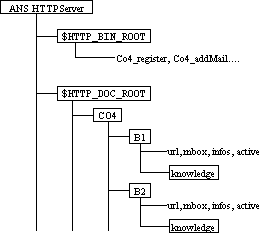Understanding the CO4 behaviour
This section presents the system behaviour of
CO4. It can help to understand the actual implementation and
installation.
The CO4 protocol takes advantage of the KAPI messaging
services, and like KAPI uses an Agent Name Server (ANS) supported by an HTTP
server to manage clients as agents. It thus requires KAPI to be installed. The
CO4 package is made of two libraries, libCo4, the main one,
and libKapi2, built on top of KAPI which adds some functions like
mailboxes, so KAPI (libkapi.a) is still required. The package also
contains 6 cgi-scripts, to deal with ANS requests:
- Co4_register and Co4_unregister to manage agent.
- Co4_deleteFile and Co4_writeFile to manage saved files.
- Co4_addMail to save mail
- Co4_directory to retrieve existing repositories
- Co4_routingScript to route HTTP requests from a browser.
These
scripts are installed in the CGI directory of the HTTP server.
A CO4 repository is a process running as a demon, exchanging
KQML messages with other CO4 repositories, for example a demand of
registration. A TCP port ("KQML port" in the remainder) is dedicated to this
repository to communicate with its peers and the corresponding URL (host and
port) is recorded by the ANS at the creation of the repository. This allows
KQML messages to only deal with repository nicknames, without knowing their
physical address.
Before each emission of a message, the ANS is requested for the URL of the
target, as shown in . Several repositories can run on the same host, by
choosing different KQML ports.

Figure . Communication scheme of the Co4 protocol. Two repositories B1 (located
on host1) and B2 (located on host2) communicate through an ANS (located on
ANS-host). B1 requests the URL of B2, so the ANS retrieves in the files of B2
its URL, tcp://host2:1000, and returns it to B1. On its side, B2 asks to save
data, so the ANS returns to it the result of the corresponding script execution
(here done).
The ANS also deals with repository management requests, because it
stores repository data, by the way of the cgi-scripts presented above. The ANS
used by CO4 has been enriched to store all data relating to the
repositories. So, let a HTTP server be on a host, with a scripts directory
located in $HTTP_BIN_ROOT, and a documents directory located in
$HTTP_DOC_ROOT. CO4 installation will copy the 6
Co4_ scripts in $HTTP_BIN_ROOT, and make a directory named
CO4 in $HTTP_DOC_ROOT. Each registered repository will have
an account in this directory CO4, to store:
- a file named url containing the URL used by KAPI (see KAPI
documentation for more information);
- a file named infos containing all the information needed by
CO4 for a successful wake up;
- a file named mbox containing pending mails;
- a file named active, whose presence indicates it the
repository is active or not;
- a directory named knowledge where all the content
is stored.
Group and individual repositories are not distinguished
in the architecture.

Figure . The various directories and files that can be found in the ANS HTTP
server.
These files and directories are created and deleted by the various cgi-scripts
that have been added in the server (see installation). These modifications
correspond to CO4 orders:
- -- a CREATE will create a new directory
named after the new repository, and create url and active.
- -- a DELETE will erase all the repository directories.
- -- a SHUTDOWN will delete the
active file, save a new infos file, and save all the knowledge files.
- -- a WAKEUP will read
infos, read and delete mbox if it is not empty, load knowledge files, and
create active.
CO4 provides a HTML interface to visualise the repository and
to manipulate the CO4 primitives. This repository behaves as a
server for some HTTP clients (web browsers). It uses another TCP port (server
port in the remainder), different from the KQML port, to communicate with its
clients, via a routing script, named Co4_routingScript and located in
$HTTP_BIN_ROOT. This script receives a URL, extracts the server port
from it, sends and receives data from the repository through that port, and
finally, returns HTML code to the browser to be displayed, as shown in .
Several servers can run on a same host, by choosing different server and KQML
ports.

Figure 4. A click on the HTML interface of B1 displayed by a browser causes a
call to the routing script, that retrieves the server port of B1
(tct://lotse:6000) from the URL, then sends data to B1, gets some HTML code
from it, and finally returns this code to the browser to be displayed. The KQML
port (tcp:5551) is always active in order to let B1 receive KQML messages send
by other repositories.


